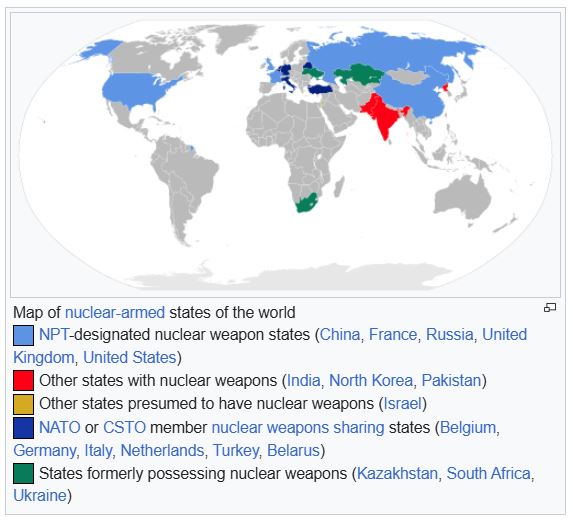Thinking About Nuclear Proliferation

Only announced nuclear states are indicated, hence Israel is not indicated in red.
I am getting questions and seeing far too many bad takes on nuclear proliferation in the Trump administration. I advise everyone to sit down quietly. Nothing is going to happen quickly, and probably a lot less than you are dooming about. I’m also writing because it’s something I think I’ve got a pretty good idea of how it works, rather than imagining the worst.
A broad understanding of the value of having nuclear weapons seems to go something like this:
- We’re going to invade you
- Haha no, we’ve got a nuclear weapon (or maybe more)
- Oh, sorry sir, we’ll invade someone else.
The way deterrence works (which is what is being discussed) is for one party to hold at risk something the other party values. The United States and the Soviet Union, after a great deal of back and forth, up and down, during the 1950s, came to a point where each had enough nuclear weapons to survive a first strike by the other and return a punishing blow. That point was the first that was at all stable, and it’s not great. We live with it today.
Let us say, then, that a small country doesn’t want to be invaded by a larger neighbor. What that small country must do is to persuade the larger neighbor that an invasion would hurt them more than it would benefit them. People are jumping to the idea that somehow the possession of nuclear weapons does that. But short of a second-strike force, the threat of nuclear weapons may not be enough.
“Having a nuclear weapon” is more than chunks of fissile material and explosive with wires attached. In order to make it a threat, there has to be some way to deliver the weapon. Which has to be weaponized – made resistant to the shocks of transit, reliably set up to explode when it is supposed to and not at other times. The delivery vehicle could be a missile or an airplane or a truck, depending on the purpose.
And then there is the question of how many nuclear weapons are a sufficient threat. A second-strike capability requires hundreds. The US and Russia have thousands. One or a few are a target to be destroyed before they can be used. If Iran were known to have assembled nuclear weapons, Israel might well have struck them by now.
This gets us into specifics. Which countries are we talking about? How many Ukrainian nuclear strikes would Russia tolerate before flattening the country?
A nuclear weapons program costs billions of dollars. It cannot be spun up overnight; a couple of years is as fast as possible if a country doesn’t have part of it in place already. The fissile material, plutonium or enriched uranium, is essential and hard to produce. Japan has a large stockpile of reactor plutonium, which, contrary to urban myth, can be used for weapons. Iran is building up a supply of enriched uranium. I think those are the only two countries that don’t have nuclear weapons already that have such inventories. Producing that material is a large part of the cost of a nuclear weapons program.
The rest is specialized explosives and detonators, although most countries could develop and produce them.
And the delivery vehicle. Missile programs are expensive, and not all countries have aircraft that could do the job.
I’m sure that a number of countries are having conversations within the government about these possibilities. It’s also possible that those conversations have had as little content as what I see online. Volodymyr Zelensky threatens to start a nuclear weapons program because it makes sense to make some noise to get attention, but it will not help him in the current fight against Russia.
The nuclear standoff between the US and Russia has come to be known as “deterrence,” and that word is badly overused by the military. In the recent trading of conventional strikes between Israel and Iran, Israel’s motive has been described as “restoring deterrence.” There are many reasons that nations do not go to war against each other. Using the word “deterrence” gives a feeling of being in control, but it may not describe the situation accurately. However, it does lead to attibuting magic powers to nuclear weapons and thus the expectation that the possession of nuclear weapons makes a nation safe.
Hamas, however, attacked nuclear-armed Israel on October 7, 2023. They were not deterred by Israel’s nuclear weapons.
The language obscures the real situation. If you believe that you are deterring someone and that if they challenge that, you must restore deterrence, you’re not thinking carefully about what caused the attack and how to respond.
Iran has found a sweet spot relative to nuclear weapons. They could have built them back in the early 2000s but didn’t, for their own reasons. Since then, they have used their enrichment capability and the possibility that they could build nuclear weapons as a deterrent. It works because Iran’s having nuclear weapons is the outcome many nations do not want. It would not work for Ukraine.
The easy equivalence nuclear weapons = deterrence lives in a lot of people’s heads, but the problem is much more than that. I wrote this piece in 2021, during the argument about whether NATO expansion alienated Russia. It has some insights that may be useful today.
Cross-posted to Nuclear Diner


